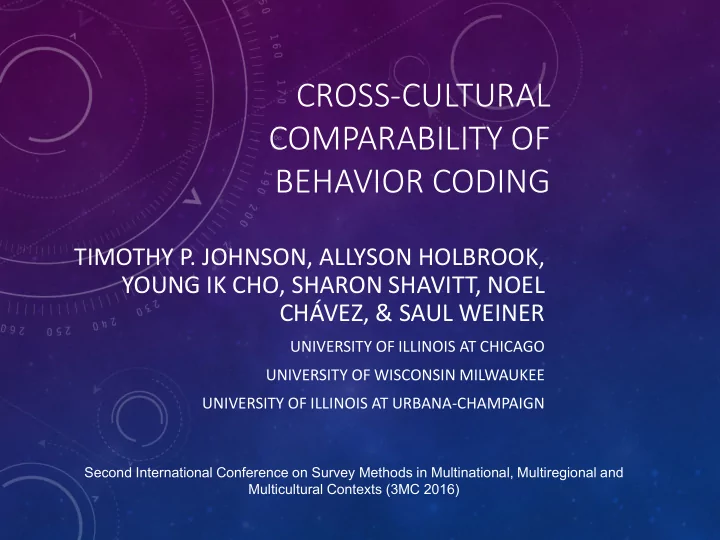

CROSS-CULTURAL COMPARABILITY OF BEHAVIOR CODING TIMOTHY P. JOHNSON, ALLYSON HOLBROOK, YOUNG IK CHO, SHARON SHAVITT, NOEL CHÁVEZ, & SAUL WEINER UNIVERSITY OF ILLINOIS AT CHICAGO UNIVERSITY OF WISCONSIN MILWAUKEE UNIVERSITY OF ILLINOIS AT URBANA-CHAMPAIGN Second International Conference on Survey Methods in Multinational, Multiregional and Multicultural Contexts (3MC 2016)
BEHAVIOR CODING • The systematic coding of interviewer and respondent behaviors • Provides an objective and replicable technique for measuring what happens in a survey interview. • Problems in comprehension and ability to provide answers can be identified from behaviors of both respondents and interviewers in consistent and interpretable ways. 2
USE OF BEHAVIOR CODES TO COMPARE QUESTION PROCESSING ACROSS CULTURES • A few studies have identified more problematic behavior codes during interviews (in English) with minority populations in the US, compared to non-Hispanic whites: • Holbrook, Cho & Johnson (2006); Cho, Holbrook & Johnson (2013); Johnson et al. (2015) • More problematic behavior codes also identified when interviews conducted in: • Spanish vs. English (Hunter & Landreth, 2005; Childs et al., 2007) • Korean vs. English & Spanish (Edwards et al., 2004) • Cross-nationally, greater mapping difficulties identified via behavior coding in the U.S. & Australia, compared to Malaysia, Mexico, Thailand and Uruguay (Thrasher et al., 2011).
UNRESOLVED: • Does culture mediate the meaning of the social behaviors captured by behavior codes? • are behavior codes comparable across cultures? • are they etic or emic?
GOAL OF THIS PRESENTATION: • Investigate the cross-cultural comparability of behavior coding
DATA SOURCE • Health Survey • Focused primarily on objective health conditions & experiences • N=603 laboratory interviews (CAPI & PAPI) • Equal numbers of African American, Korean American, Mexican American, and non-Hispanic whites interviewed • Interviews conducted in English, Korean & Spanish • All interviews digitally recorded and subsequently behavior coded by trained/supervised staff • All data was collected in Chicago by UIC Survey Research Laboratory • Questionnaire included several intentionally “bad” questions
INTENTIONALLY BAD QUESTIONS EXAMINED • TRACINES: “Have you ever tried to cut down on the amount of tracines in your diet?” (Yes/no) • EMISSARIUM: “Has a doctor or other health care professional ever told you that you have a hyperactive emissarium?” (yes/no) • ORDINAL HEALTH: “How worried are you about your ordinal health? Would you say very worried, somewhat worried, only a little worried, or not worried at all?”
OTHER QUESTIONS EXAMINED • GLOBAL HEALTH: “In general, would you say your health is excellent, very good, good, fair, or poor?” • MENTAL HEALTH: “How would you rate your overall mental health? Would you say excellent, very good, good, fair, or poor?”
COMPREHENSION PROBLEM CODES • Clarification (Unspecified): Respondent indicates uncertainty about question, but it is unclear as to whether the problem is related to the construct or the context. • Clarification (Construct/Statement): Respondent makes a statement indicating uncertainty about question meaning. • Clarification (Construct/Question): Respondent asks for clarification of question meaning. • Clarification (Context): Respondent indicates s/he understands the meaning of the construct, but indicates uncertainty about question meaning within the context of the question as stated. • Clarification (Time frame): Respondent indicates uncertainty about the question's time frame. • Qualified answer (Uncertainty): Respondent gives answer, but answer is qualified to indicate uncertainty about accuracy. This can include a distinct uncertainty in the R’s tone. • Respondent asks for repeat of question: Respondent asks interviewer to repeat the question, or part of the question.
MAPPING PROBLEM CODES • Inadequate answer (General ): Respondent gives answer that does not meet question objective. Response usually prompts probing. • Clarification (Response format): Respondent indicates uncertainty about the format for responding. • Respondent asks for repeat of response options: Respondent asks interviewer to repeat the response options, or some of the response options, only. • Clarification (Response option meaning): Respondent asks for clarification of a response option meaning. • Rewording (Response options): Respondent rephrases/repeats the response options, or some of the response options, before answering. This is not an indication of needing response option clarification. • Imprecise response (Different response option ): Respondent gives answer that does not use the response options provided with the question. Response usually prompts probing. • Imprecise response (Inferred answer): Respondent gives answer that does not use the response options provided for the question. However, sufficient information is provided by the respondent to infer the correct answer. Response can prompt probing or confirmation.
FINDINGS
“HAVE YOU EVER TRIED TO CUT DOWN ON THE AMOUNT OF TRACINES IN YOUR DIET?”
“HAS A DOCTOR OR OTHER HEALTH CARE PROFESSIONAL EVER TOLD YOU THAT YOU HAVE A HYPERACTIVE EMISSARIUM?”
“How worried are you about your ordinal health? Would you say very worried, somewhat worried, only a little worried, or not worried at all?”
“In general, would you say your health is excellent, very good, good, fair, or poor?”
“How would you rate your overall mental health? Would you say excellent, very good, good, fair, or poor?”
SUMMARY • Behavior coding may be useful for examining both: • information processing difficulties, and • Acquiescence • Behavior codes appear to be at comparable across cultures at least in part. • Question of absolute measurement equivalence across cultures and languages remains unresolved • Limitations • Data limited to the US, four race/ethnic groups, three languages • Non-probability sample
THANKS FOR YOUR QUESTIONS. TIMJ@UIC.EDU
Recommend
More recommend